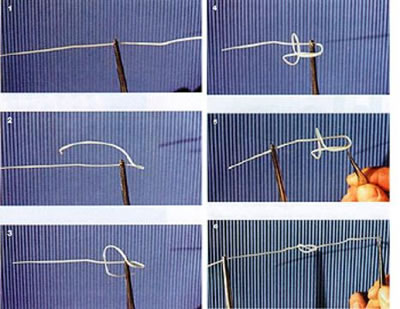Science Fiction
Dictionary
A B C D E F G H I J K L M N O P Q R S T U V W X Y Z
Shape-Memory Polymers Temperature Morphing

Shape-memory polymers created by researchers from MIT and the Institute of Polymer Research in Germany can morph into three different structures - and then revert back to its original shape - in response to specific changes in temperature.
See the shape-shifting polymers do their thing in the video below; it shows a fastener which unfolds itself and then extends two arms to secure the structure to a plastic container. This item could be used on assembly lines to fasten small parts in difficult-to-reach places.
(Shape-shifting polymer has three temperature-controlled shapes)
Another unique use for shape-memory polymers is proposed in biodegradable sutures that shape themselves.

(Shape-memory polymer biodegradable sutures)
To test this concept, researchers Dr Andreas Lendlein and Dr Robert Langer made sutures by heating fibers of their ‘shape shifting’ material to 50°C. They were then stretched to three times their length and cooled to room temperature. These extended fibers were then used to loosely stitch a wound on a rat. When the suture was heated to 41°C (just above body temperature), the thread tightened and closed the wound, applying just the right amount of pressure (0.1 N). Later, after the wound is healed, the material is designed to dissolve and is harmlessly absorbed by the body.
Like those shape-memory toys?
- Soft Robot Powered By Shape Memory Alloy Spokes
A remarkable new kind of robotic locomotion has emerged in the form of small "robots" that are constructed in the shape of a wheel. - British 'Serpentine Spy' wriggles with shape-memory alloy
Click through and then scroll down a bit to see this very early bot. - Robotany Bonzai Robot
A unique ambient robot/tree combo.
More on shape-memory polymers and shape-memory biodegradable sutures.
Scroll down for more stories in the same category. (Story submitted 11/25/2006)
Follow this kind of news @Technovelgy.| Email | RSS | Blog It | Stumble | del.icio.us | Digg | Reddit |
Would
you like to contribute a story tip?
It's easy:
Get the URL of the story, and the related sf author, and add
it here.
Comment/Join discussion ( 0 )
Related News Stories - (" Material ")
Harvard Metamaterials Change Structure Instantly
'Annealed in any shape for a time, and codified, the structure of that shape is retained down to the molecules.' - Samuel R. Delany
Nano-Chainmail 2D Mechanically Interlocked Polymer
'Nemourlon armor of reasonable weight resists penetration by most fragments and any bullet that is not both reasonably heavy and fairly high-velocity.' - Jerry Pournelle, 1976.
Goldene - A Two-Dimensional Sheet Of Gold One Atom Thick
'Hasan always pitched a Gauzy - a one-molecule-layer tent, opaque, feather-light, and very tough.' - Roger Zelazny, 1966.
FlexRAM Liquid Metal RAM And One Particular SF Movie Robot
'Its lines wavered, flowed, and then painfully reformed.' - Philip K. Dick, 1957.
Technovelgy (that's tech-novel-gee!) is devoted to the creative science inventions and ideas of sf authors. Look for the Invention Category that interests you, the Glossary, the Invention Timeline, or see what's New.
Science Fiction
Timeline
1600-1899
1900-1939
1940's 1950's
1960's 1970's
1980's 1990's
2000's 2010's
Current News
The Zapata Air Scooter Would Be Great In A Science Fiction Story
'Betty's slapdash style.'
Thermostabilized Wet Meat Product (NASA Prototype)
There are no orbiting Michelin stars. Yet.
Could Crystal Batteries Generate Power For Centuries?
'Power could be compressed thus into an inch-square cube of what looked like blue-white ice'
India Ponders Always-On Smartphone Location Tracking
'It is necessary... for your own protection.'
Amazon Will Send You Heinlein's Knockdown Cabin
'It's so light that you can set it up in five minutes by yourself...'
Is It Time To Forbid Human Driving?
'Heavy penalties... were to be applied to any one found driving manually-controlled machines.'
Replace The Smartphone With A Connected Edge Node For AI Inference
'Buy a Little Dingbat... electropen, wrist watch, pocketphone, pocket radio, billfold ... all in one.'
Artificial Skin For Robots Is Coming Right Along
'... an elastic, tinted material that had all the feel and appearance of human flesh and epidermis.'
Robot Guard Dog On Duty
I might also be thinking of K-9 from Doctor Who.
Wearable Artificial Fabric Muscles
'It is remarkable that the long leverages of their machines are in most cases actuated by a sort of sham musculature...'
BrainBridge Concept Transplant Of Human Head Proposed
'Briquet’s head seemed to think that to find and attach a new body to her head was as easy as to fit and sew a new dress.'
Google's Nano Banana Pro Presents Handwritten Math Solutions
'...copy was turned out in a charming and entirely feminine handwriting.'
Edible Meat-Like Fungus Like Barbara Hambly's Slunch?
'It was almost unheard of for slunch to spread that fast...'
Sunday Robotics 'Memo' Bot Has Unique Training Glove
'He then started hand movements of definite pattern...'
Woman Marries Computer, Vonnegut's Dream Comes True
'Men are made of protoplasm... Lasts forever.'
Natural Gait With Prosthetic Connected To Nervous System
'The leg was to function, in a way, as a servo-mechanism operated by Larry’s brain...'
